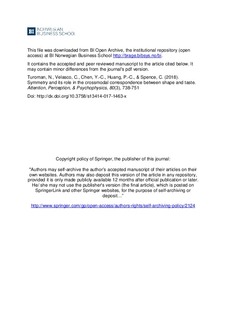Symmetry and its role in the crossmodal correspondence between shape and taste
Journal article, Peer reviewed
Accepted version
Date
2018Metadata
Show full item recordCollections
- Publikasjoner fra CRIStin - BI [1015]
- Scientific articles [2181]
Original version
Attention, Perception & Psychophysics. 2018, 80(3), 738-751 10.3758/s13414-017-1463-xAbstract
Despite the rapid growth of research on the crossmodal correspondence between visually presented shapes and basic tastes (e.g., sweet, sour, bitter, and salty), most studies that have been published to date have focused on shape contour (roundness/angularity). Meanwhile, other important features, such as symmetry, as well as the underlying mechanisms of the shape–taste correspondence, have rarely been studied. Over two experiments, we systematically manipulated the symmetry and contours of shapes and measured the influences of these variables on shape–taste correspondences. Furthermore, we investigated a potential underlying mechanism, based on the common affective appraisal of stimuli in different sensory modalities. We replicated the results of previous studies showing that round shapes are associated with sweet taste, whereas angular shapes are associated with sour and bitter tastes. In addition, we demonstrated a novel effect that the symmetry group of a shape influences how it is associated with taste. A significant relationship was observed between the taste and appraisal scores of the shapes, suggesting that the affective factors of pleasantness and threat underlie the shape–taste correspondence. These results were consistent across cultures, when we compared participants from Taiwanese and Western (UK, US, Canada) cultures. Our findings highlight that perceived pleasantness and threat are culturally common factors involved in at least some crossmodal correspondences.
Description
The accepted and peer reviewed manuscript to the article
